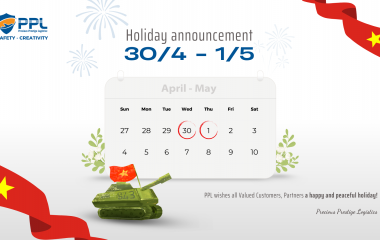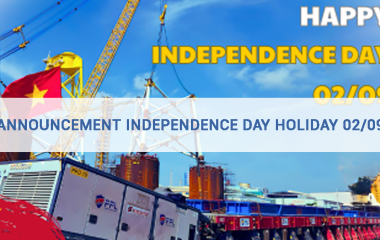Strengthening connectivity makes Vietnam a logistics center
Government Resolution No. 163/NQ-CP states: The goal is to turn logistics services into a high-value service industry and link their development to local and international trade, manufacturing goods and infrastructure for transportation, enhancing connectivity to make Vietnam an important logistics center in the region; develop logistics associated with sustainable supply chains; improve the quality of human resources; promoting digital transformation and technology application; expanding the logistics service market; focus on improving the competitiveness of logistics service enterprises. For the food industry in Vietnam, green logistics plays an important role in ensuring the efficient and sustainable transportation of food products, while minimizing negative impacts on the environment.
The socio-economic situation in Ho Chi Minh City in May has some positive points such as the Index of Industrial Production (IIP) estimated to increase by 1.5% over the previous month and by 5.5% compared to the previous month. with the same period; In general, in the first 5 months of 2023, the IIP index in the city increased by 1.6% over the same period. In which, logistics is one of the most important business sectors of Vietnam. This is an area that contributes to the development of the national economy through the provision of goods transportation and supply chain management services.

According to Mr. Nguyen Tuan, Deputy Director of the Investment and Trade Promotion Center of Ho Chi Minh City (ITPC), the new trend is green logistics – an important link to “green” the food supply chain. In 2023, in the context that consumers increasingly prefer environmentally friendly products, the “greening” of the logistics industry and application of green logistics is a mandatory requirement. This means that the logistics industry must diversify solutions to “green” in aspects such as green transportation, green packaging, green warehousing, green logistics data management. Thus, if the logistics industry wants to develop stronger to meet the needs of exporting goods, it must first “restructure” itself, such as optimizing delivery routes, reducing the number of empty trucks or half-carrying goods. on the road to save fuel and transportation costs. In particular, in the context that “greening” is a mandatory requirement, throughout from production to transportation to consumption, the logistics industry cannot stand aside, if it wants to survive and support exports.
With the same view, Mr. Duong Anh Duc, Vice Chairman of Ho Chi Minh City People’s Committee shared that Vietnam’s agricultural products and processed foods are present in over 180 countries and territories. Many industries in this field have contributed more than 1 billion USD to the annual export turnover, especially some industries such as seafood have contributed more than 10 billion USD. Not only that, Vietnam has actively participated in many free trade agreements, export tax reduction conditions from markets around the world have opened up more opportunities for enterprises’ exports. Vietnam. However, to take advantage of this opportunity, it is necessary to improve the capacity of the logistics industry.
Ms. Do Thi My Le, Sales Director of Trung Minh Thanh Co., Ltd. said, if using water transport, the company has to cost 10%/total product value; but if using air freight, the cost will be 2 times the total product cost. Not stopping there, sea transport serving export enterprises also depends on foreign shipping lines. Therefore, for many years, enterprises have faced many difficulties and delayed delivery due to having to wait for container pairing or waiting for a trip arranged by shipping lines.
With the same opinion, Mr. Hoang Manh Cuong, Director of Vinaxo Co., Ltd., analyzed that Vietnam’s logistics industry has many limitations, such as: Fragmented logistics industry The logistics industry in Vietnam is still fragmented, with many businesses small and medium enterprises operate independently. Lack of coordination and standardization in logistics services, Inefficiency and increased costs. Many logistics service providers in Vietnam lack the technological capabilities and expertise required to provide high-quality logistics services. Poor inventory management, etc., and slow delivery. Although Vietnam has invested significantly in infrastructure development, there are still areas where infrastructure is inadequate or needs improvement. For example, the road and rail networks in some areas may not be sufficient to meet the needs of the growing logistics industry. Some regulatory barriers, such as complicated customs procedures and strict licensing requirements, slow down the development of the logistics industry in Vietnam. Making it difficult for logistics service providers to operate efficiently and compete with foreign enterprises.
Dr. Ton That Tu, an international consultant, said that road transport in Vietnam accounted for 74.4% of the total transport volume compared to other means of transport, followed by inland waterways accounting for more than 19%; while railway, sea and air accounts for a relatively modest proportion. In particular, if considering the demand for logistics transport of enterprises, sea transport accounts for more than 68%, followed by road, air and other means.
/1.png)
Related Posts
New Posts
- PPL successfully performs site-move and load-out of record-breaking 4,000-ton offshore substation topside fabricated by PV Shipyard
- HOLIDAY ANNOUNCEMENT: REUNIFICATION DAY & INTERNATIONAL LABOR DAY (April 30 - May 1, 2025)
- ANNOUNCEMENT OF HUNG KINGS’ COMMEMORATION DAY 2025
- PTSC Thanh Hoa and PPL Sign Strategic Partnership
- INDEPENDENCE DAY HOLIDAY ANNOUCEMENT
- PPL Teambuilding 2024: Uniting Our Strength, Igniting Success!



_cr_380x240.png)



Comments